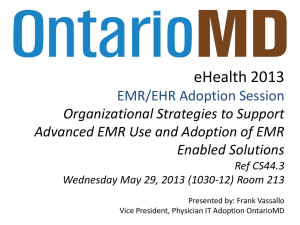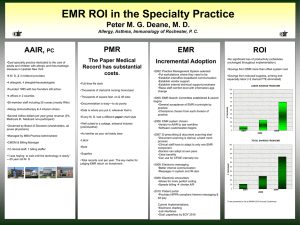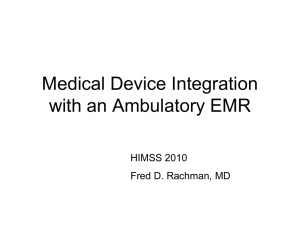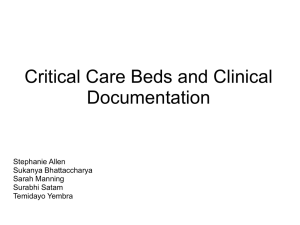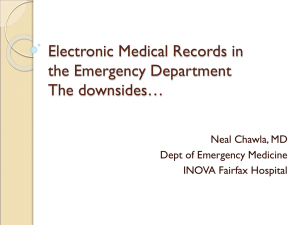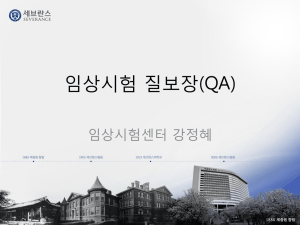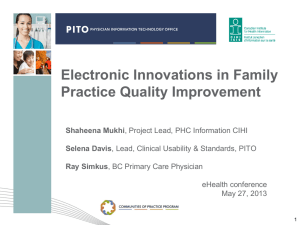Quality Measures: (QA/QI) - National Association of State Veterans
advertisement
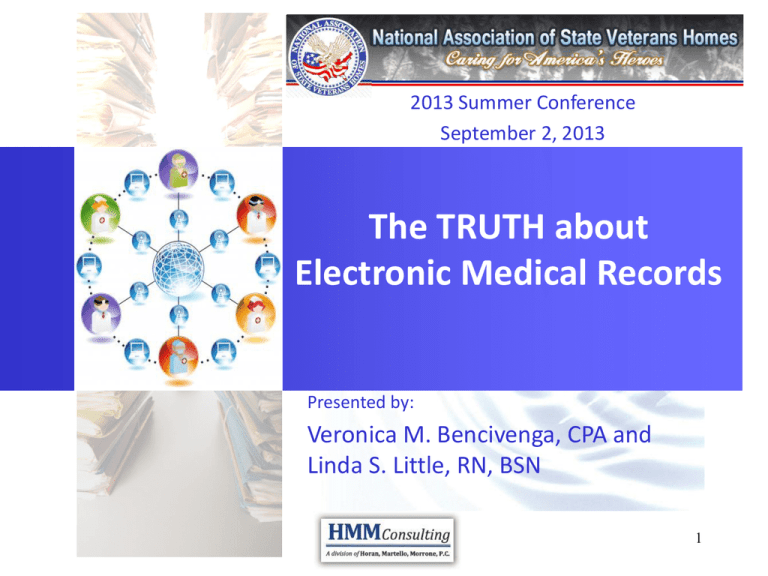
National Association of State Veteran’s Homes 2013 Summer Conference September 2, 2013 The TRUTH about Electronic Medical Records Presented by: Veronica M. Bencivenga, CPA and Linda S. Little, RN, BSN 1 Today’s Agenda… The 7 Truths of EMR Implementation EMR Project Phases Symptoms of Project Failure Critical ingredients for Project Success Disaster Recovery Planning 2 Truth about EMR 7 Truths of EMR Implementation: • Selecting a vendor is HARD • EMR WILL NOT fix poor workflow/performers • ALL departments need to be included in planning • Training and project management are CRITICAL to success and can be the biggest expense • Workflow MUST be changed (process not same as paper) • Productivity is REDUCED in the early stages causing overtime and increased staffing • EMR is a series of overlapping investments whose benefit accumulates OVER TIME 3 Key EMR Modules Clinical Modules Financial Modules Census/ADT MDS Document Management Business Intelligence, Analytics Care Plans Physician Orders Assessments Progress Notes e-MAR/e-TAR Weights/Vitals Point of Care Third Party Software: Therapy QI/QA Billing/Claims Management Accounts Receivable Collections Referral Management Patient Trust Accounts Payable General Ledger 4 Three EMR Project Phases Phase 1 – Planning Phase 2 – Implementation Phase 3 Integration 5 Three EMR Project Phases Phase 1 PLANNING (3-9 Months) • Establish Scope, Goals and Objectives • Assessment • Project Team • Vendor Search • Project timeline and milestones Phase 2 IMPLEMENTATION (3-4 Months) • • • • System build Testing Training Go-Live • • • • Phase 3 INTEGRATION PHASE 3 (6-12 Months) INTEGRATION Guide and monitor utilization Training and Re-Training Update policies and procedures QA (QI\QM) 6 Phase 1 - Planning Establish Scope, Goals and Objectives Assessment Project Team • Start with the end in mind • Re-visit often and revise as needed during the Planning Stage • • • • • Management commitment Utilization of existing systems Effectiveness of current workflow practices Computer skills Current IT Infrastructure (Network, computers, databases, interfaces, etc.) • Interdisciplinary • Project Manager 7 Phase 1 - Planning • FACT: There is NO perfect product Vendor Search • Decision should be based on: • Features, functionality and delivery model that support your organizational goals and objectives (not the bells and whistles) • Support provided by the vendor after installation (dedicated support, on-line education, webinars, news letters, etc.) • Results of Vendor due diligence including product demonstrations, site visits, reference checks, plans for future product development, financial health and longevity of vendor 8 Phase 1 - Planning Vendor Search (continued) • Delivery Model Options: • Single Solution vs. Multi-Vendor • Ability of in-house Software Administrator to manage multiple vendors and interfaces • Hosted (ASP, SaaS) VS. Local • Understanding of current infrastructure, growth plans and the trade off between control (security/compliance) and cost 9 Phase 2 - Implementation System Build • Creates the foundation (tables, rules, parameters, security templates etc.) and drives information flow • Most clinical data is paper based so a lot of data entry required to populate the initial database (like active medication orders, etc.) • Even electronic clinical data is rarely a 1:1 match to new format so manual data entry or manipulation of data required • Clinical data that is “imported” or “populated” will not trigger the logic checks and controls in the system Testing • Work with Pharmacy, Lab and Radiology vendors to validate information exchange • The best testing happens in the first 4-6 weeks after “Go-Live” once real data is in the system 10 Phase 2 - Implementation Training • Limit training of new information to 4hrs • ALL staff, ALL shifts must be trained • Offer additional “Open Training” sessions for anyone who needs extra help • Work closely with Nurse Scheduler to ensure proper staff coverage during training and distribution of trained staff on each shift (buy her something nice before, during and after training) Go-Live • Go-Live when you walk out of training • Hands on support of every shift absolutely critical the first few weeks after each module goes live 11 Phase 3 – Integration Guide and monitor workflow/ utilization Training and Re-training (yes, more training) • Users need to know what to do when they back to their desk • Establish process for reporting issues, resolving them and communicating findings back to the users • This is evolutionary and should go on for 12-18 months • Establish training policy for new employees • Schedule and support re-training and new training for existing employees several times a year 12 Phase 3 – Integration Update policies and procedures • Best to update after first year using system as process will evolve as users get better with the system and provide feed back about what works and what doesn’t from the original plan QA (QI\QM) • Begin utilizing reports ASAP and scrubbing or fine tuning as needed 13 Quality Measures (QA/QI) Quality Measures: (QA/QI) • Nursing homes use quality measures to review and improve the quality of the care they give to residents. • Clinical measures for nursing home residents, such as the percent of residents with pressure ulcers, with moderate to severe pain, or residents who have changes in their ability to move about. This information is collected as LIVE data and entered in the EMR by the nursing home on all residents and shows how well nursing homes care for their residents’ physical and clinical needs. • The EMR system allows for you to organize, track, search and report on your indicators. 14 Quality Measures (QA/QI) Indicators • • • • Indicator Data Set-up To identify trends, patterns and exceptions Measurable Real time data Quality Improvement • Track tasks and progress of any improvements to address trends and patterns identified • Valuable insight into Clinical issues • Utilization of facility specific data for QA Reports • Interdisciplinary • Can be broken down by Diagnosis, Unit, Staff, Assessment etc… • Accurate data leads to quality information that is required for quality decision making and resident care. 15 Quality Measures (QA/QI) Nursing home quality measures have four primary purposes: 1. Help you choose a nursing home for yourself or others; 2. Understand care at nursing homes where you or family members already live; 3. Facilitate discussions with nursing home staff regarding the quality of care; and 4. Provide data to help with quality improvement efforts. The nursing home quality measures come from resident assessment data, that collected into the EMR provides real time documentation. Real time data provides the most accurate information. The assessment data is converted to develop quality measures that give consumers another source of information to show how well nursing homes are caring for their resident's physical and clinical needs. 16 Quality Measures (QA/QI) QA monitoring is critical for early detection of care delivery issues, ensuring complete and timely records, and auditing workflow processes. • • Track new antibiotic orders, Infections report; UTI monitor to assist with the identification of UTI’s which is now being used as part of fall assessment Monthly Report of Nosocomial Infections – which calculates monthly attack rate, break down by unit as well as individual type of infections; PT/INR orders for all Residents on Coumadin. • O2, G/T and Foley audits, Restraint audit, Hypnotic/psychotropic review, • – • look for any antipsychotics that are ordered PRN. Review chart to ensure order has a specific duration (i.e.,1 week, and have appropriate documentation in place). Identify if the facility is triggering any specific areas that might need improvement (i.e., falls, pain etc…) 17 Quality Measures (QA/QI) QA monitoring (continued): • Weight loss reports to identify causes and prevent further losses • Occurrence Reports to facilitate identification of trends and causal factor • Foley Catheter Use and UTI’s • Advance directive reports; • Reports to ensure all documentation requirements by Physicians have been completed • CNA ADL coding to insure capturing of highest RUG 18 Symptoms of Project Failure An IT project has failed when: – The users are happy because they can make the new system work just like the old system (successful failure) – Users are “working around” the system to get their job done, creating inefficiencies – The users are utilizing less than 20% of the functionality of the system after 6 months (the Menu Test) – No critical business processes were changed during the project – Users can’t identify 3 ways the new system is better than what they had before 19 Critical Ingredients For Success Critical ingredients for EMR success: – Project Management • Utilize internal or external resources to keep the project on target and moving forward – Sufficient planning • Understand the scope of the project and the effect on the organization’s operations • Evaluate and improve core business processes. Goals need to be clear and changes need to “make sense”. – Commitment • EMR adoption is an ongoing process, budget resources for future maintenance and development • Training, training and more training • Designate a “Software Administrator” – Manage expectations • Guide expectations of all stakeholders (staff, department heads, Owners, Board of Directors, etc.) with respect to what can be achieved, by whom and when 20 Critical Ingredients For Success Managing EMR Expectations: – Timeframe • No instant gratification – multiple stages over months or years – Productivity/Workflow • Workflow WILL/MUST change • Users will experience inefficiencies at various stages of the project (expect overtime) • There will be trial and error • Won’t fix poor performing employees – Resources • Clearly identify point person • ANNUAL BUDGET for project management, hardware, initial training, on-going training – Compliance • Monitor and enforce consistent utilization by all users • Update Policies and Procedures, Staff education, etc. • Tie compliance to job performance 21 Disaster Recovery Planning 22 Disaster Recovery Planning Disaster Recovery: The process, policies and procedures related to preparing for recovery or continuation of technology infrastructure critical to an organization after a natural or human-induced disaster. Types of Disasters you should be prepared for are: Accidental or Malicious Deletion of Data Communication Failure Data or Software Corruption Fire and/or Water Damage Hard Drive Failure Theft or Vandalism 23 Disaster Recovery Planning Business Continuity Planning: A plan for how to recover and restore partially or completely interrupted critical functions within a predetermined time Focus on Mission Critical Infrastructure (MCI) (data, software, equipment) How long to restore MCI (the faster you need it, the more it costs) 24 Disaster Recovery Planning EMR Considerations: Different from other Systems (Payroll, Billing) Downtime is not an Option Contingency Planning: A Paper Backup Plan – Need process for: – – – – Printing treatments and orders Documenting on paper Pushing paper back into the system Audit for completeness after emergency over Expect the need for paper backup – Practice the Plan – Be prepared to revise as needed 25 Disaster Recovery Planning Key Site Issues: Power – Perform generator tests – Identify changes to “e-outlets” since implementing EMR (may need to add or reallocate existing) Communication – Internet – Establish redundant internet connectivity – Have Wi-Fi hot-spot (3g and 4g) or wireless cards – Have local (plug-in play) printers available 26 Thank you. Questions? ? 27 HMM Consulting a Division of Horan, Martello, Morrone P.C. Veronica M. Bencivenga, CPA Linda S. Little, RN, BSN Office (631)265-6289 Cell (631)880-2882 VBencivenga@horanmm.com www.horanmm.com Office (631)265-6289 Cell (631)880-9214 LLittle@horanmm.com www.horanmm.com 28
